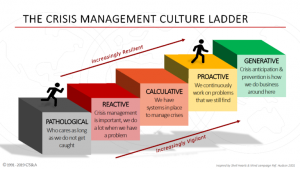The Four R’s of Emergency & Risk Communications Management
Today, I thought we could discuss the four R’s that are essential to effective emergency & risk communications. If you remember these four steps, you can develop and empower any team to do their very best in both readiness and response state.
1. RESILIENCY – Many practitioners have been building the theme of resiliency into their strategic models; however, more often than not it’s added as a ‘nice to have’ item. Fact is though, resiliency is the ability to recover, adapt or grow in response to threat or challenge. If you’re not tapped into ways of building resiliency, you’re not tapped in at all.

So, what are some ways you can start building resiliency into your readiness program? Well, it means building out the other three R’s of your Emergency and Risk communications program. What are the risks to your organization; how often are you training to ensure there’s a continuous baseline of expertise and awareness. How ready are you to respond to an event?
2. READINESS – In a 2019 Crisis readiness survey (PRNEWS) data revealed that only 62% of organizations have a crisis readiness plan, and only 49% of those plans are actually up-to-date. What’s more concerning though, is that 40% of respondents indicated they have never conducted an exercise. Not only does exercising test your readiness (preparedness) it also provides you with an opportunity to learn from mistakes – before they happen in ‘real-life’. Exercise your team, activate your plan, test your spokespeople, and fill in any gaps BEFORE you have to respond to an event. When we worked with a major city in Alberta training their Crisis Communications Team, for many of them it was their first time ever participating in an exercise and proved to be an eyeopening experience.
3. RESPONSE – The 3rd ‘R’ in Emergency and Risk Communications is, you guessed it, Response. This is when all the dress rehearsals will hopefully pay off. It’ll also be the time when your biggest areas of weakness and risk are exposed. The most important aspect to remember in a time of response is that the biggest opportunity lies within what you learn from the experience. Document as much as possible, so that you can evaluate and incorporate lessons learned as you head into the recovery.
4. RECOVERY – The final R is recovery. Firstly, there needs to be an acknowledgement (recognition) that the crisis is over and you’re now shifting into recovery mode; exercising will help you learn what the signs are. Now, it’s time to assess what the damage is to reputation, morale, etc. and to recalibrate your efforts around that. Next, it’s time for repairing. What do you need to do in order to ‘make it right’ in the aftermath of the crisis? How do you redirect people’s attention and efforts toward optimism and hope? What do you need to do to re-establish and reinforce trust, your values, relationships? [Pro tip: there are six more R’s you can add to the list in the recovery phase alone].
The people we see doing this the best are the ones who are committed to preparedness and dedicated to the people they serve. This is why we are so passionate about what we do because we know that preparedness saves money, time, reputations, and lives.
If you want to chat more about this, book a virtual coffee with me, we’d love to hear from you!
